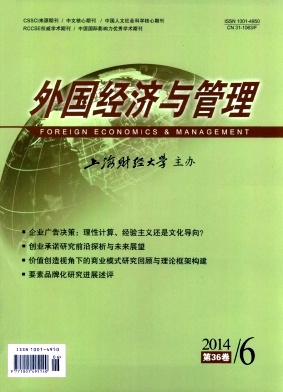要素品牌化研究进展述评
外国经济与管理 2014 年 第 36 卷第 06 期, 页码:42 - 50
摘要
参考文献
摘要
要素品牌化作为一种提升要素供应商与相关终端制造商竞争优势的有效手段,在实践领域已得到广泛应用,并受到国外学术界的关注。本文按照要素品牌化实施主导方的不同,将要素品牌化划分为由要素供应商主导的和由终端制造商主导的两种,然后分别从这两个视角,对要素品牌化的内涵进行了归纳和总结,并对国内外要素品牌化的研究现状进行了梳理,最后对未来研究方向进行了展望,以期为要素品牌化实践与后续研究提供有益的参考和借鉴。
[1]Baumgarth C.Evaluations of co-brands and spill-over effects:Further empirical results[J].Journal of Marketing Communications,2004,10(2):115-131.
[2]Desai K K and Keller K L.The effects of ingredient branding strategies on host brand extendibility[J].Journal of Marketing,2002,66(1):73-93.
[3]Dickinson S and Heath T.A comparison of qualitative and quantitative results concerning evaluations of co-branded offerings[J].Journal of Brand Management,2006,13(6):393-406.
[4]Erevelles S,et al.An analysis of B2Bingredient co-branding relationships[J].Industrial Marketing Management,2008,37(8):940-952.
[5]Ghosh M and John G.When should original equipment manufacturers use branded component contracts with suppliers?[J].Journal of Marketing Research,2009,46(10):597-611.
[6]Han S-L and Sung H-S.Industrial brand value and relationship performance in business markets—A general structural equation model[J].Industrial Marketing Management,2008,37(7):807-818.
[7]Kotler P and Pfoertsch W.Ingredient branding:Making the invisible visible[M].Heidelberg:Springer Verlag,2010.
[8]Lienland B,et al.The undervaluation of corporate reputation as a supplier selection factor:An analysis of ingredient branding of complex products in the manufacturing industry[J].Journal of Purchasing&Supply Management,2013,19(2):84-97.
[9]Linder C and Seidenstricker S.The strategic meaning of ingredient brands:A resource-based analysis[J].Asian Journal of Marketing,2010,4(1):1-16.
[10]Linder C.Ingredient branding in sports markets:The case Makrolon and UVEX[J].International Journal of Business and Globalization,2011,7(4):485-496.
[11]Lou Y-C,et al.Ingredient branding alliances:An investigation of brand awareness and feedback[A].Borghini S,McGrath M and Otnes C C(Eds.).European advances in consumer research[C].Duluth,MN:Association for Consumer Research,2008,8:232-233.
[12]Luczak C A,et al.In-branding:Development of a conceptual model[J].Academy of Marketing Studies Journal,2007,11(2):123-137.
[13]McCarthy M and Norris D G.Improving competitive position using branded ingredients[J].Journal of Product&Brand Management,1999,8(4):267-285.
[14]Norris D G.Ingredient branding:A strategy option with multiple beneficiaries[J].Journal of Consumer Marketing,1992,9(3):19-31.
[15]Park W,et al.Composite branding alliances:An investigation of extension and feedback effects[J].Journal of Marketing Research,1996,33(4):453-466.
[16]Pfoertsch W,et al.Measuring the value of ingredient brand equity at multiple stages in the supply chain:A component supplier’s perspective[J].Interdisciplinary Management Research,2008,4(5):571-595.
[17]Rao A R,et al.Signaling unobservable product quality through a brand ally[J].Journal of Marketing Research,1999,36(2):258-268.
[18]Simonin B L and Ruth J A.Is a company know by the company it keeps?Assessing the spillover effects of brand alliances on consumer brand attitudes[J].Journal of Marketing Research,1998,35(1):30-41.
[19]Swaminathan V and Reddy S K.Spillover effects of ingredient branded strategies on brand choice:A field study[J].Marketing Letters,2012,23(1):237-251.
[20]Tiwari K and Singh R.Perceived impact of ingredient branding on host brand equity[J].Journal of Marketing and Management,2012,3(1):60-77.
[21]Uggla H and Filipsson D.Ingredient branding:Strategic guidelines[J].ICFAI Journal of Brand Management,2008,5(2):16-30.
[22]Vaidyanathan R and Aggarwal P.Strategic brand alliances:Implications of ingredient branding for national and private label brands[J].European Journal of Operational Research,2000,9(4):214-228.
[23]Washburn J H,et al.Co-branding:Brand equity and trial effects[J].Journal of Consumer Marketing,2000,17(7):591-604.
[24]Washburn J H,et al.Brand alliance and customer-based brand-equity effects[J].Psychology&Marketing,2004,21(7):487-508.
[25]Wise R and Zednickova J.The rise and rise of the B2Bbrand[J].Journal of Business Strategy,2009,30(1):4-13.
[26]陆娟,边雅静.不同元素品牌联合模式下的主品牌联合效应研究[J].管理世界,2010,(10):114-122.
[27]王海忠等.要素品牌策略与产品独特性评价:自我建构和产品性质的调节作用[J].南开管理评论,2012,15(4):111-117.
[2]Desai K K and Keller K L.The effects of ingredient branding strategies on host brand extendibility[J].Journal of Marketing,2002,66(1):73-93.
[3]Dickinson S and Heath T.A comparison of qualitative and quantitative results concerning evaluations of co-branded offerings[J].Journal of Brand Management,2006,13(6):393-406.
[4]Erevelles S,et al.An analysis of B2Bingredient co-branding relationships[J].Industrial Marketing Management,2008,37(8):940-952.
[5]Ghosh M and John G.When should original equipment manufacturers use branded component contracts with suppliers?[J].Journal of Marketing Research,2009,46(10):597-611.
[6]Han S-L and Sung H-S.Industrial brand value and relationship performance in business markets—A general structural equation model[J].Industrial Marketing Management,2008,37(7):807-818.
[7]Kotler P and Pfoertsch W.Ingredient branding:Making the invisible visible[M].Heidelberg:Springer Verlag,2010.
[8]Lienland B,et al.The undervaluation of corporate reputation as a supplier selection factor:An analysis of ingredient branding of complex products in the manufacturing industry[J].Journal of Purchasing&Supply Management,2013,19(2):84-97.
[9]Linder C and Seidenstricker S.The strategic meaning of ingredient brands:A resource-based analysis[J].Asian Journal of Marketing,2010,4(1):1-16.
[10]Linder C.Ingredient branding in sports markets:The case Makrolon and UVEX[J].International Journal of Business and Globalization,2011,7(4):485-496.
[11]Lou Y-C,et al.Ingredient branding alliances:An investigation of brand awareness and feedback[A].Borghini S,McGrath M and Otnes C C(Eds.).European advances in consumer research[C].Duluth,MN:Association for Consumer Research,2008,8:232-233.
[12]Luczak C A,et al.In-branding:Development of a conceptual model[J].Academy of Marketing Studies Journal,2007,11(2):123-137.
[13]McCarthy M and Norris D G.Improving competitive position using branded ingredients[J].Journal of Product&Brand Management,1999,8(4):267-285.
[14]Norris D G.Ingredient branding:A strategy option with multiple beneficiaries[J].Journal of Consumer Marketing,1992,9(3):19-31.
[15]Park W,et al.Composite branding alliances:An investigation of extension and feedback effects[J].Journal of Marketing Research,1996,33(4):453-466.
[16]Pfoertsch W,et al.Measuring the value of ingredient brand equity at multiple stages in the supply chain:A component supplier’s perspective[J].Interdisciplinary Management Research,2008,4(5):571-595.
[17]Rao A R,et al.Signaling unobservable product quality through a brand ally[J].Journal of Marketing Research,1999,36(2):258-268.
[18]Simonin B L and Ruth J A.Is a company know by the company it keeps?Assessing the spillover effects of brand alliances on consumer brand attitudes[J].Journal of Marketing Research,1998,35(1):30-41.
[19]Swaminathan V and Reddy S K.Spillover effects of ingredient branded strategies on brand choice:A field study[J].Marketing Letters,2012,23(1):237-251.
[20]Tiwari K and Singh R.Perceived impact of ingredient branding on host brand equity[J].Journal of Marketing and Management,2012,3(1):60-77.
[21]Uggla H and Filipsson D.Ingredient branding:Strategic guidelines[J].ICFAI Journal of Brand Management,2008,5(2):16-30.
[22]Vaidyanathan R and Aggarwal P.Strategic brand alliances:Implications of ingredient branding for national and private label brands[J].European Journal of Operational Research,2000,9(4):214-228.
[23]Washburn J H,et al.Co-branding:Brand equity and trial effects[J].Journal of Consumer Marketing,2000,17(7):591-604.
[24]Washburn J H,et al.Brand alliance and customer-based brand-equity effects[J].Psychology&Marketing,2004,21(7):487-508.
[25]Wise R and Zednickova J.The rise and rise of the B2Bbrand[J].Journal of Business Strategy,2009,30(1):4-13.
[26]陆娟,边雅静.不同元素品牌联合模式下的主品牌联合效应研究[J].管理世界,2010,(10):114-122.
[27]王海忠等.要素品牌策略与产品独特性评价:自我建构和产品性质的调节作用[J].南开管理评论,2012,15(4):111-117.
引用本文
李桂华, 黄磊, 卢宏亮. 要素品牌化研究进展述评[J]. 外国经济与管理, 2014, 36(6): 42–50.
导出参考文献,格式为:
下一篇:消费者敌意研究脉络梳理及未来展望





 6058
6058  698
698

